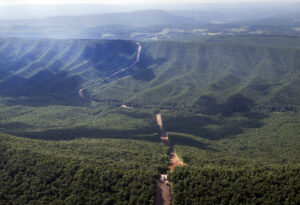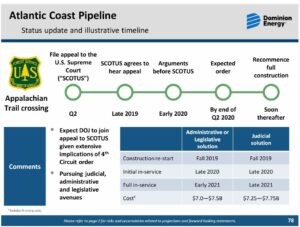
The building season is here, but for developers of Virginia’s two hotly-contested natural gas pipelines, activity is back in the government agencies and courthouses. The construction sites remain largely silent, delays running up the ultimate cost of the projects, including the cost of failure.
Here is my (probably flawed) attempt at a status report. And you thought Game of Thrones is a complicated plot.
Dominion Energy’s leadership told stockholders on March 25 that it is hoping to “recommence at least partial construction” on the Atlantic Coast Pipeline (ACP) in the third quarter of this year, and the Mountain Valley Pipeline is still talking about being in service by the end of this year on its website. One national rating agency expressed concerns about the ACP several weeks ago, the Richmond Times-Dispatch reported. A few days later another analyst told Forbes readers about the challenges facing both pipelines.
Just listing all of the permit challenges and lawsuits facing the Mountain Valley Pipeline (MVP) and ACP projects is difficult enough, let alone trying to describe their status. A report back in January by Rob Rains of Washington Analysis LLC, which Bacon’s Rebellion could review but not share, listed battles over seven different kinds of permits for one or both projects, three lawsuits challenging the MVP and seven challenging the ACP.
The ACP at the federal level is still working to re-acquire right of way permits needed to build on U.S. Forest Service land, permits needed to build across waterways, permits needed to build across or under the Blue Ridge Parkway and Appalachian Trail, and permission to build where it might disturb endangered species. It has state-supervised permits under the Clean Water Act for its Virginia sections. It has its main FERC permit intact but is having to defend it in federal court. It is suing Nelson County over local permit denials.
The MVP at the federal level also has its main FERC permit under legal assault, it also needs to regain permission to build across certain waterways, and it has right of way issues involving the Bureau of Land Management as well as the National Forest Service. It also now needs restored permission to cross the Appalachian Trail. It also has its Virginia-regulated Clean Water Act permits for its Virginia sections. It doesn’t seem to have problems with the Fish and Wildlife Service.
Nelson is ground zero, where the ACP (48 percent owned by Dominion Energy) plans to tunnel under the Blue Ridge Parkway. It’s the Civil War Battle of Missionary Ridge all over again, with the pipeline developer desperate to hold high ground it thought safe. The U.S. Fourth Circuit late last year remanded the National Park Service’s permit for a Blue Ridge Parkway crossing, and then in February the court opined that only an act of Congress could approve crossing the Appalachian Trail.

In the investor presentation Dominion discussed the timing of a possible Supreme Court appeal or effort in Congress over the Trail decision. An optimistic schedule would have a Supreme Court decision at least a year away. Analyst Rains is predicting the response instead will be a change in the permit process, a new joint oversight effort involving both the U.S. Forest Service and the Interior Department. That will require a rulemaking but may carry less risk than taking the question straight to Congress.
The Fourth Circuit has also vacated the U.S. Forest Service’s special use permit for the ACP to cross its lands and has stayed U.S. Fish and Wildlife Service approvals because of alleged ACP impact on four endangered species: a bee, a bat, a mussel and a crustacean. It is that endangered species problem along 100 miles of its route that the ACP hopes to solve in time to restart partial construction this year.
That restart would involve just the eastern section of the project, from its intersection with the existing Transco pipeline (near that controversial compressor station in Buckingham) down into North Carolina, along with the planned spur into the Hampton Roads region. The north and western section, connecting to the West Virginia gas fields by crossing the mountains, must await a resolution on the Parkway and Appalachian Trail. That raises the possibility that only the eastern section is built, providing additional distribution east and south from that existing trunk line.
Both MVP and ACP are also re-applying for their Corps of Engineers permits to build across various waterways, with the MVP challenging a 72-hour work limit to complete four of the larger projects. Rain’s March 29 status report has both pipelines marked with yellow for caution, but that’s better than several others around the country marked in orange or red to suggest deeper peril.
Rains does not expect either developer will get much help from a new Executive Order signed by President Donald Trump in Texas last week, described in this report from National Public Radio.
Both Virginia pipelines still hold permits from the Federal Energy Regulatory Commission (FERC) and, so far, those have survived challenges. The opponents are now pursuing appeals of those in the DC Court of Appeals, one step below the Supreme Court, with the petition challenging the ACP filed permit April 5. The petition (here) combines a host of opponents, provides a summary of all the arguments being used – environmental, environmental justice and economic – and seeks that the permit be vacated, remanded to FERC, and all eminent domain activity cease.

Leave a Reply
You must be logged in to post a comment.